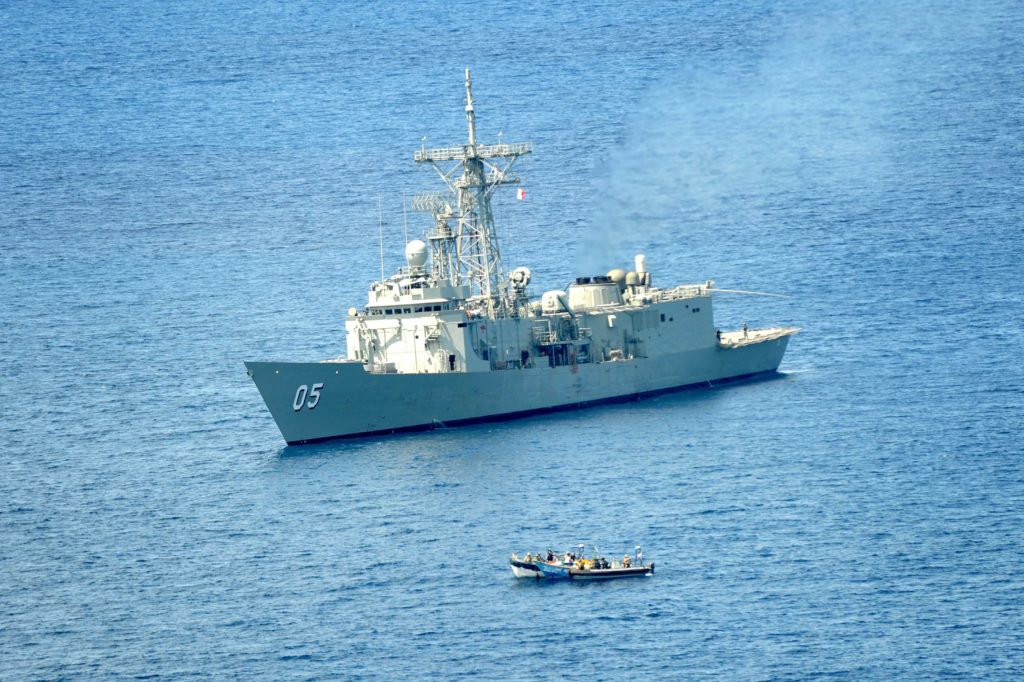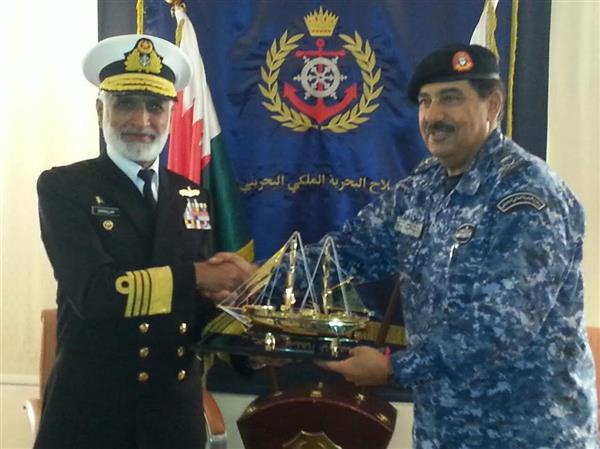The Pakistan Navy is one of the more powerful and experienced navies indigenous to the Indian Ocean. It has played its part in ensuring peace and co-operation in the Indian Ocean Region and continues to strive do so. Though on an individual basis, it is the main guarantor of stability in the northern reaches of Arabian Sea that carry the energy and maritime trade links to and from the Gulf; the most high profile examples of the Pakistan Navy efforts to ensure regional peace and stability have come during instances of co-operation with other navies. Indeed today its contribution to the Combined Maritime Forces (CMF) security endeavour through missions CTF-150 (established to counter terrorism and illegal use of the sea), and CTF-151 (an Anti-piracy Task Force), are probably its most high profile. CMF is quite unique in being comprised of 30 nations all making entirely voluntary contributions. Pakistan’s contributions to CTF-150 and CTF-151 (both of which are regularly commanded by Pakistan navy) have been maintained despite a shortfall in the number of warships, an indication of just how importantly Pakistan Navy considers its contribution to regional peace and stability.
A testament to Pakistan Navy’s individual contribution and the effectiveness of the overall co-operative effort is reflected in the fact that though the region continues to experience instability, the situation at sea is calm, with free movement of shipping. It is therefore valid to highlight contributions of Pakistan Navy in this overall effort considering its longstanding commitment. In September 2001 Pakistan found itself drawn into the maelstrom of the war on terror as a frontline state, and there was an obvious maritime dimension. The intervention in Afghanistan saw a vast array of naval power arrayed in the Arabian Sea to support the operation, but there was also a need to stop any terrorists fleeing Afghanistan and gaining access to the sea from where they could escape to the Gulf and beyond. The attack on the French registered oil super tanker Limburg in October 2002 as she tried to enter the Yemeni port of Aden brutally reinforced the vulnerability of regional shipping, and also the cost this could have to the global economy (as indeed was the aim of the attack). If maritime chokepoints and ports could not be secured, if the safety of ships at sea could not be guaranteed, the global economy would suffer greatly. The Arabian Sea and surrounding waters were deemed particularly at risk due to the energy bearing maritime trade routes emanating from the Gulf. The entire region had to be secured, but this was by no means an easy task as it was far too large to be protected and patrolled by any single navy. CTF-150 actually started life as a US Navy Task Force, but was transformed in 2002 into a multinational force mainly comprising US and some European NATO allies plus Japan. Pakistan Navy joined the CTF-150 in 2004 and has since been a key member, first taking Command of the CTF-150 in 2006, and subsequently commanding the force nine times till to date.
CTF-150 is responsible for an area that includes some of the world’s busiest shipping lanes (transporting a third of the world’s oil) that covers over two million square miles, and encompasses the Gulf of Oman, Gulf of Aden, the Red Sea, and the North Arabian Sea. Familiarity with the region made Pakistan Navy an essential participant in CTF-150. Indeed, during Pakistan Naval Chief Admiral Muhammad Zakaullah’s recent visit to Bahrain this was asserted by the commander US Naval Forces Central Command (NAVCENT), Vice Admiral Kevin M Donegan. NAVCENT is itself part of US Central Command (CENTCOM) under which CMF was established. During discussion with Admiral Zakaullah on matters of mutual interest, including bilateral naval collaboration and security environment in the Indian Ocean Region, Admiral Donegan appreciated the professionalism of Pakistan Navy personnel and the role played by Pakistan Navy in ensuring regional security and stability. He also attributed much of the success in this regard to the almost constant presence of Pakistan Navy in the region that has established and maintained conditions to allow the continued freedom of navigation for regional shipping. This increased level of security has not only stemmed acts of terrorism at sea, but also other forms of illegal activity that may help hide it.

Though CTF-150 has been instrumental in ensuring regional security and stability it had a major shortcoming in relation to a new security threat that emerged in the middle of the 2000s, it lacked a mandate to tackle piracy. With a literal explosion in attacks by Somali pirates, first off the Horn of Africa, and later increasingly out into the Indian Ocean, there was a demand for action which resulted in the formation in 2009 of a new dedicated Task Force, CTF-151. As a result of the sterling work Pakistan Navy did in contributing to CTF-150, and in further recognition of Pakistan as a state crucial to regional security/ stability efforts, it joined CTF-151 at the first instance and was the first regional state to command the force, also doing so on a number of occasions subsequently. It should be remembered that at the time Pakistan’s economy was hardly in the best of health, something exacerbated by the global economic downturn and rising energy prices. Ever dependent on the sea for its economic survival, Pakistan had little choice but to join CTF-151 as the plague of piracy was also playing havoc with international shipping further endangering its economic health even though relatively few Pakistani flagged ships were being taken. With over 12 percent by volume of oil transported by sea passing through piracy infested waters the cost to the global economy was calculated to be up to US$12 billion. The rising cost of shipping due to increased insurance costs was something that could be ill afforded. The first to suffer directly however, were Pakistani fishermen, with the first fishing vessel captured at the end of 2009 and used as a ‘mothership’ in order to increase the pirates’ range to launch attacks further out into the Indian Ocean region. In 2010, the first Pakistani fatality at the hands of the pirates occurred with the murder of the Pakistani captain of a ship carrying sugar to the Somali port of Bossaso. There was little Pakistan Navy could do on its own to protect its citizens at sea on numerous merchantmen, but through its participation in CTF151 the tide slowly turned against the pirate gangs as the International Recommended Traffic Corridor that passes from the Bab el Mandeb out into the Gulf of Oman was gradually made safe. As recognition for Pakistan’s efforts in this regard, Pakistan has been regularly participating in UN Contact Group on Piracy that was established in response to UNSC Resolution 1851 to better co-ordinate the response to Somali piracy.
Though Pakistan Navy’s frigates assigned to the two CMF missions are regularly in the news, one aspect of Pakistan’s contribution to both forces is its deployment of maritime patrol aircraft. These are the largely unsung assets that can patrol huge areas of sea in a single mission and provide real time response to a crisis. Aircraft were often the first CMF assets on scene in an emergency to ascertain the facts of the situation, establish contact with any parties in need of assistance, and relay that information back to CMF headquarters in Bahrain. Pakistan’s longest range/endurance assets are its P-3C Orions though it is also in the process of modernizing its latest ATR-72 Maritime Patrol Aircraft. Given the interoperability with aircraft from other CMF partners that deploy the P-3C or its derivatives, however, the Pakistani Orion fleet is the natural choice for the mission.
Another element of both CTF-150 and CTF-151 is capacity building and training with local navies to enhance partnerships with regional forces. Pakistan already has considerable experience in this respect due to having trained many of the Gulf navies and also continuing to train a wide range of personnel from regional navies at its own institutions. There is obviously always more that Pakistan Navy itself can learn through interacting and operating with other navies, but for many of the regional navies the capacity to individually deal with the twin threats of piracy and terrorism simply are not present (and in some cases may never be because of the size and limited capabilities of those forces). Practicing capabilities such as small boat interdiction drills, search and rescue at sea, helicopter operations and ship manoeuvres, are all vital skills in conducting Maritime Interdiction Operations. Additionally, increased interaction helps break down barriers and improved co-operation with regional forces, which can only have a positive outcome.
In sum, the constant presence of Pakistan Navy throughout the region has made it safe for all. Though over 90 percent of Pakistan’s trade is sea borne, other regional states, especially those of the Gulf who receive probably over 80 percent of their food by the sea, have also benefited. It is not only in Pakistan’s interests to maintain its regional security commitments, but in the interest of all regional states. Through the efforts of Pakistan Navy it is clear for all that Pakistan is a responsible state and an active partner in international collaborative efforts to ensure maritime security. The CMF’s missions would certainly be a lot harder without Pakistan’s across the spectrum contributions. Pakistan Navy can truly be said therefore to punch above its weight by ensuring peace and co-operation in the Indian Ocean region.




